DelveInsight’s report, “Juvenile Idiopathic Arthritis Market Insight, Epidemiology and Market Forecast – 2032,” reveals that the Juvenile Idiopathic Arthritis therapeutic landscape across the United States, EU4 (Germany, France, Italy, and Spain), the United Kingdom and Japan is growing noticeably, underpinned by advancements in targeted therapies (such as biologics and JAK inhibitors), increased investment in research and development, and the introduction of innovative diagnostic tools.
The United States holds the largest market share in terms of both revenue and patient pool across 7MM, primarily due to better diagnosis, the highest pharmaceutical spending per capita globally, and significant drug development efforts with the presence of major Juvenile Idiopathic Arthritis drug companies in the country.
Download the Juvenile Idiopathic Arthritis Market report to understand market dynamics and treatment landscape trends.
DelveInsight’s epidemiological modelling underscores that Juvenile Idiopathic Arthritis, the most common chronic rheumatic disease of childhood, continues to present significant clinical and economic challenges across the 7MM.
Studies show that females are generally more affected than males by Juvenile Idiopathic Arthritis, although this trend varies depending on the specific subtype, with enthesitis-related JIA notably showing a male predominance.
Furthermore, the DelveInsight report details country-specific diagnosed Juvenile Idiopathic Arthritis patient pools from 2019 to 2032 and highlights a steady upward trend driven by heightened diagnostic vigilance and improved registry coverage. Notably, the United States captures the largest share of identified Juvenile Idiopathic Arthritis cases, whereas Germany leads within the European countries, reflecting regional variations in paediatric rheumatology infrastructure and reporting mechanisms.
Discover evolving trends in the Juvenile Idiopathic Arthritis patient pool forecasts @ Juvenile Idiopathic Arthritis Epidemiology Analysis.
The Juvenile Idiopathic Arthritis treatment landscape has evolved considerably, transitioning from conventional non-steroidal anti-inflammatory drugs (NSAIDs) and disease-modifying antirheumatic drugs (DMARDs) to sophisticated biologic and targeted synthetic agents that inhibit key inflammatory pathways. Although methotrexate retains a central role as an anchor DMARD, an expanding class of tumour necrosis factor (TNF) inhibitors, interleukin (IL) blockers and Janus kinase (JAK) inhibitors has reshaped the Juvenile Idiopathic Arthritis therapeutic paradigm, offering clinicians greater flexibility for refractory disease.
According to the DelveInsight report, the Juvenile Idiopathic Arthritis therapies pipeline shows promising development activity. New developments in Juvenile Idiopathic Arthritis therapies are focused on targeted approaches, particularly JAK inhibitors. Tofacitinib and baricitinib are two JAK inhibitors that have been approved for use in specific Juvenile Idiopathic Arthritis subtypes, primarily in cases where patients haven’t responded well to other treatments like TNF inhibitors. Baricitinib, for instance, has shown efficacy in patients with polyarticular Juvenile Idiopathic Arthritis, extended oligoarticular Juvenile Idiopathic Arthritis, enthesitis-related arthritis, and psoriatic Juvenile Idiopathic Arthritis aged 2 to 18 years. Tofacitinib has also been shown to be effective in patients with polyarticular course Juvenile Idiopathic Arthritis.
Furthermore, the competitive intelligence section of the report highlights novel agents targeting cytokine signalling beyond TNF and IL-6, as well as next-generation oral molecules designed to optimise patient adherence. Robust evaluation of launch timelines, annual cost of therapy, and forecast clinical differentiation suggests a wave of innovative entrants that could meaningfully expand the Juvenile Idiopathic Arthritis drugs in the coming decade.
Dive Deeper into the evolving treatment landscape @ Juvenile Idiopathic Arthritis Emerging Therapies.
Key opinion leader insights collected through primary research validate these trends and pinpoint persistent gaps such as limited treatment options for systemic Juvenile Idiopathic Arthritis flares, glucocorticoid sparing strategies, and long-term safety surveillance in growing children. KOLs also emphasise the need for biomarkers that can guide personalised therapeutic sequencing and predict disease trajectory, a frontier that remains largely unaddressed despite significant scientific advances. Addressing these challenges offers significant opportunities for innovative biotech and pharma entities to carve out competitive advantages in an increasingly crowded market landscape.
Looking ahead, the Juvenile Idiopathic Arthritis market is poised to benefit from deeper understanding of disease pathogenesis, breakthrough device-assisted drug-delivery platforms and collaborative research networks that accelerate paediatric trial recruitment. While significant strides have been made, continued innovation in immune-modulation, tolerability optimisation and health-equity initiatives will be essential to fully meet the unmet needs of this vulnerable patient population. Stakeholders who leverage DelveInsight’s granular insights stand to capitalise on the forthcoming wave of therapeutic progress and capture value in a market primed for transformative growth through 2032.
Table of Contents
1. Key Insights
2. Executive Summary of Juvenile Idiopathic Arthritis
3. Competitive Intelligence Analysis for Juvenile Idiopathic Arthritis
4. Juvenile Idiopathic Arthritis Market Overview at a Glance
5. Juvenile Idiopathic Arthritis: Disease Background and Overview
6. Juvenile Idiopathic Arthritis Patient Journey
7. Juvenile Idiopathic Arthritis Epidemiology and Patient Population
8. Treatment Algorithm, Current Treatment, and Medical Practices
9. Juvenile Idiopathic Arthritis Unmet Needs
10. Key Endpoints of Juvenile Idiopathic Arthritis Treatment
11. Juvenile Idiopathic Arthritis Marketed Products
12. Juvenile Idiopathic Arthritis Emerging Therapies
13. Juvenile Idiopathic Arthritis: Seven Major Market Analysis
14. Attribute analysis
15. 7MM: Market Outlook
16. Access and Reimbursement Overview of Juvenile Idiopathic Arthritis
17. KOL Views
18. Juvenile Idiopathic Arthritis Market Drivers
19. Juvenile Idiopathic Arthritis Market Barriers
20. Appendix
21. DelveInsight Capabilities
22. Disclaimer
23. About DelveInsight
Related Reports
Juvenile Idiopathic Arthritis Pipeline Insight
Juvenile Idiopathic Arthritis pipeline insight provides comprehensive insights about the Juvenile Idiopathic Arthritis pipeline landscape, pipeline drug profiles, including clinical and non-clinical stage products, and the Juvenile Idiopathic Arthritis companies, including Novartis, Roche, AbbVie, AstraZeneca, Pfizer, Eli Lilly, and Incyte Corporation, among others.
About DelveInsight
DelveInsight is a leading market research and consulting firm specializing in disease-specific insights and therapeutic market analysis. Their reports integrate real-world data, clinical trial findings, and expert interviews to deliver comprehensive industry intelligence.
Media Contact
Company Name: DelveInsight Business Research LLP
Contact Person: Arpit Anand
Email: Send Email
Phone: +14699457679
Address:304 S. Jones Blvd #2432
City: Las Vegas
State: Nevada
Country: United States
Website: https://www.delveinsight.com/consulting/due-diligence-services

